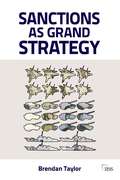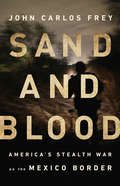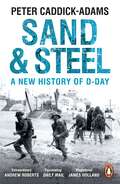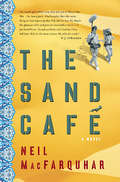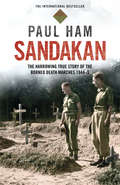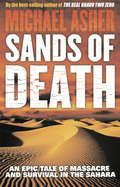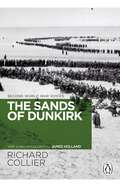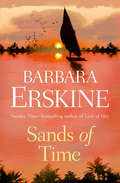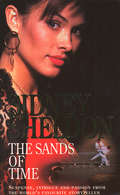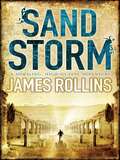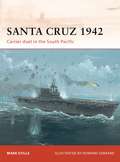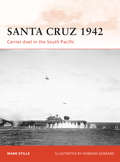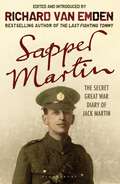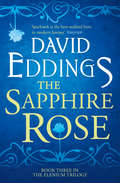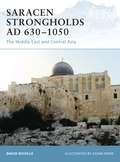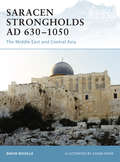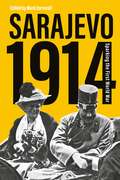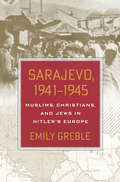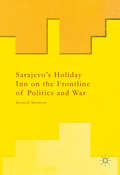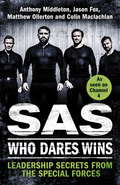- Table View
- List View
Sanctions as Grand Strategy: Sanctions As Grand Strategy (Adelphi series)
by Brendan TaylorEconomic sanctions are becoming increasingly central to shaping strategic outcomes in the twenty-first century. They afford great powers a means by which to seek to influence the behaviour of states, to demonstrate international leadership and to express common values for the benefit of the international community at large. Closer to home, they can also offer a 'middle way' for governments that apply them, satisfying moderates and hardliners alike. For some great powers in the multipolar world order, however, they pose a threat to trading relationships. They may also serve as a prelude to military action. With China's international voice growing in prominence and Russia asserting its renewed strength, often in opposition to the use of sanctions, it will be ever more difficult to reach a consensus on their application. Against this backdrop, knowing what kind of measures to take and in which scenarios they are most likely to work is invaluable. This Adelphi focuses on the different sanctions strategies of the United States, China, Russia, Japan and the EU, with regard to the unfolding nuclear crises in Iran and North Korea. It examines how these measures, designed to marginalise the regimes in both countries and restrict their ability to develop nuclear weapons, have also influenced the sanctioning states' international partners. As such, they are not just a tool of statecraft: they are potentially an important facet of grand strategy.
Sanctions as Grand Strategy (Adelphi series)
by Brendan TaylorEconomic sanctions are becoming increasingly central to shaping strategic outcomes in the twenty-first century. They afford great powers a means by which to seek to influence the behaviour of states, to demonstrate international leadership and to express common values for the benefit of the international community at large. Closer to home, they can also offer a 'middle way' for governments that apply them, satisfying moderates and hardliners alike. For some great powers in the multipolar world order, however, they pose a threat to trading relationships. They may also serve as a prelude to military action. With China's international voice growing in prominence and Russia asserting its renewed strength, often in opposition to the use of sanctions, it will be ever more difficult to reach a consensus on their application. Against this backdrop, knowing what kind of measures to take and in which scenarios they are most likely to work is invaluable. This Adelphi focuses on the different sanctions strategies of the United States, China, Russia, Japan and the EU, with regard to the unfolding nuclear crises in Iran and North Korea. It examines how these measures, designed to marginalise the regimes in both countries and restrict their ability to develop nuclear weapons, have also influenced the sanctioning states' international partners. As such, they are not just a tool of statecraft: they are potentially an important facet of grand strategy.
Sanctity as literature in late medieval Britain (Manchester Medieval Literature and Culture)
by Anke Bernau E. Von ContzenThis collection explores some of the many ways in which sanctity was closely intertwined with the development of literary strategies across a range of writings in late medieval Britain. Rather than looking for clues in religious practices in order to explain such changes, or reading literature for information about sanctity, these essays consider the ways in which sanctity - as concept and as theme - allowed writers to articulate and to develop further their 'craft' in specific ways. While scholars in recent years have turned once more to questions of literary form and technique, the kinds of writings considered in this collection - writings that were immensely popular in their own time - have not attracted the same amount of attention as more secular forms. The collection as a whole offers new insights for scholars interested in form, style, poetics, literary history and aesthetics, by considering sanctity first and foremost as literature
Sand and Blood: America's Stealth War on the Mexico Border
by John Carlos FreyA damning portrait of the U.S.-Mexico border, where militaristic fantasies are unleashed, violent technologies are tested, and immigrants are targeted.Over the past three decades, U.S. immigration and border security policies have turned the southern states into conflict zones, spawned a network of immigrant detention centers, and unleashed an army of ICE agents into cities across the country.As award-winning journalist John Carlos Frey reveals in this groundbreaking book, the war against immigrants has been escalating for decades, fueled by defense contractors and lobbyists seeking profits and politicians--Republicans and Democrats alike--who relied on racist fear-mongering to turn out votes. After 9/11, while Americans' attention was trained on the Middle East and the wars in Iraq and Afghanistan, the War on Terror was ramping up on our own soil--aimed not at terrorists but at economic migrants, refugees, and families from South and Central America seeking jobs, safety, and freedom in the U.S.But we are no safer. Instead, families are being ripped apart, undocumented people are living in fear, and thousands of migrants have died in detention or crossing the border.Taking readers to the Border Patrol outposts, unmarked graves, detention centers, and halls of power, Sand and Blood is a frightening, essential story we must not ignore.
Sand and Steel: A New History of D-Day
by Peter Caddick-AdamsThe most comprehensive and authoritative history of D-Day ever published‘Extraordinary’ Andrew Roberts‘Brilliant’ Jeremy Black‘Magisterial’ James Holland________________6 June 1944, 4 a.m. Hundreds of boats assemble off the coast of Normandy. By nightfall, thousands of the men they carry will be dead.Through their sacrifice, the Allies will gain a foothold in Europe that will ultimately lead to the downfall of the Third Reich.This was D-Day, the most important day of the twentieth century.________________In Sand and Steel, one of Britain’s leading military historians draws on a decade of archival research and thousands of interviews to offer a panoramic new account of the Allied invasion of France.Peter Caddick-Adams masterfully recreates what it was like to wade out onto the carnage of Omaha Beach, facing the machine-gun fire that wiped out whole battalions of troops. He delves into how the Allied generals came to choose Normandy in June 1944, and describes the extraordinary subterfuge that went into keeping the decision secret. And he recounts how the operation transformed the lives of Britons back home, transforming sleepy villages in the Home Counties into bustling military outposts. His findings offer revelatory new insights into our understanding of D-Day. Sand and Steel is the only book to discuss the experiences of every major military force: not just the infantrymen on the beaches, but also the paratroopers, sailors and aircrew, resistance fighters in France, women on the Home Front, and even the German Wehrmacht. It offers the first full analysis of the year-long invasion preparations, revealing that more men died in training exercises than during the landing itself. Above all, it pays tribute to soldiers of all nationalities, demonstrating that the often-overlooked UK and Canadian were just as crucial to victory as the American forces were. The result is an authoritative and compulsively readable exploration of the most important battle in history. It will be the definitive work on D-Day for years to come.________________PRAISE FOR SAND AND STEEL‘Whether you are a visitor to the Normandy battlefields, a general reader interested in the greatest amphibious assault in the history of warfare, or just someone who appreciates extremely well-written military history . . . this truly extraordinary book is undoubtedly the one for you.’ Andrew Roberts‘Following his excellent study of the Battle of the Bulge, Caddick-Adams does it again by explaining, as opposed to simply describing, the Allies’ victory.’ Jeremy Black‘Peter Caddick-Adams is unquestionably one of the very finest historians of the Second World War . . . His D-Day must surely go down as the definitive narrative of that pivotal moment in the history of the war.’ James Holland
The Sand Cafe: A Novel
by Neil MacFarquharDhahran Palace Hotel, Saudi Arabia, 1991. The US forces are massing on the border with Iraq, preparing to throw Saddam Hussein out of Kuwait. Men and material are arriving daily, helicopters and armor are training in the desert sand. There are rumors of Scud missiles, talk of the possibility of chemical attack, but in fact, nothing is really happening. With no story to report, the press is getting restive. The Sand Café is a satire of modern war reporting that mercilessly exposes the life of the foreign correspondent: endless scurrying trips in pursuit of a really big story, gathering frustration, brewing jealousy directed towards other reporters, especially those from better financed TV networks, and the stale smell of damp rot that comes from a combination of leaking air-conditioning and wretched carpeting in the hotel where the entire bedraggled press corps is housed. Boredom massages idle thoughts into wild excesses, even in a country that officially bans the sale of alcohol. Neil MacFarquhar, a veteran of the Middle East foreign press corps, has written a woundingly witty black comedy of those who bring us news from the front lines, exposing their vanities, rivalries and petty distractions. Love, lust for fame and the magnificent gilded hypocrisy of the regime in Saudi make this novel as revealing as it is compelling.
Sandakan: The Untold Story Of The Sandakan Death Marches
by Paul HamAfter the fall of Singapore in 1942, the conquering Japanese Army transferred some 2500 British and Australian prisoners to a jungle camp at Sandakan, on the east coast of North Borneo. There they were beaten, broken, worked to death, thrown into bamboo cages on the slightest pretext and subjected to tortures so ingenious and hideous that the victims were driven to the brink of madness. But it was only to be the beginning of the nightmare. In late 1944 when Allied aircraft began bombing the coastal towns of Sandakan and Jesselton, the Japanese resolved to abandon the prison camp and move the prisoners 250 miles inland to Ranau. The journey there became known as the Sandakan Death marches. Of the thousand plus prisoners who set out on the epic marches, only six survived. This is both their story and the story of the fallen.
Sands of Death: An Epic Tale Of Massacre And Survival In The Sahara
by Michael AsherDesert explorer Michael Asher investigates the most disastrous exploration mission in the history of the SaharaIn December 1880 a French expedition attempted to map a route for a railway that would stretch from their colony in Algeria right across the Sahara desert to reach their territories in West Africa. 'Paris to Timbuctoo in Six Days' was the slogan. It would do for the French colonies what the American railways were doing in the western states at the same time. No native opposition was expected. As one of the expedition's organizers said, 'A hundred uncivilized tribesmen armed with old-fashioned spears: what is that against the might of France?' Four months later, a handful of emaciated survivors staggered into a remote outpost on the edge of the desert. Although armed with modern rifles, the column had been lured to destruction by the self-styled 'lords of the desert', the Tuareg. At this, the highpoint of European colonialism in Africa, this story of treachery, massacre, torture and even cannibalism made headlines around the world. Attacked by the Tuareg in their remote heartland, the survivors had been pursued for weeks on end, driven into the waterless desert to die. The desperate lengths they resorted to shocked Victorian sensibilities. They do not make easy reading now. This grisly story, told by our greatest living desert explorer reveals what happened when the conceit of western colonialism met the equally arrogant Tuareg, who had dominated this remote region, and anyone trying to cross it, for a thousand years.
The Sands of Dunkirk
by Richard CollierPart of the SECOND WORLD WAR VOICES series, with a new introduction by bestselling historian James Holland, and in partnership with the podcast We Have Ways of Making You Talk, presented by comedian Al Murray and James HollandMay 1940: In the face of a lightning German advance, the British Army found themselves, stunned, broken, beaten, their backs truly against the wall on the sands of the north French coast.And yet it was on the beaches of Dunkirk that the seeds of a remarkable victory were sown. The evacuation of over three hundred thousand men in ships of all sizes was a logistical feat which has never been seen, before or since.This vivid, visceral story takes you inside the making of a miracle: the story of eight frantic days, as the net tightened around the beleaguered troops, told from all sides, as the enemy draws closer and the bombardment intensifies, in the words of those who were there. It is impossible to get closer to experiencing this legendary action.
Sands of Time
by Barbara ErskineA spine-tingling collection of haunting tales, from the Sunday Times bestselling author of Lady of Hay.
The Sands of Time: The Sands Of Time (Sheldon Continuity Ser.)
by Sidney SheldonFOUR WOMEN AND THE MEN THEY ARE FORBIDDEN TO LOVE
Sandstorm: The first adventure thriller in the Sigma series (SIGMA FORCE #Bk. 1)
by James Rollins'Rollins is what you might end up with if you tossed Michael Crichton and Dan Brown into a particle accelerator together' New York TimesAn inexplicable explosion rocks the antiquities collection of a London museum - and sets off alarms in clandestine organisations around the world...Lady Kara Kensington's family paid a high price in money and blood to found the gallery that now lies in ruins. And her search for answers is about to lead her into a world she never imagined existed: a lost city, buried beneath the Arabian desert, where something astonishing is waiting...A covert government operative hunting down a traitor is being drawn there. But at the end of a perilous journey lies an ageless power that can create a utopia - or tear down everything humankind has built over millennia of civilisation...'A non-stop thrill-a-minute ride' Tess Gerritsen
Santa Baby: Sexy Reads For Cold Winter Nights
by Lorraine Wilson Vonnie Davis Sun Chara Charlotte PhillipsA 5 book festive collection of steamy romance tales. Perfect for snuggling up on those long, cold winter nights . . .
Santa Cruz 1942: Carrier duel in the South Pacific (Campaign #247)
by Howard Gerrard Mark StilleDespite myth, the Japanese carrier force was not destroyed at Midway but survived to still prove a threat in the Pacific Theater. Nowhere was this clearer than in the battle of Santa Cruz of October 1942. The stalemate on the ground in the Guadalcanal campaign led to the major naval forces of both belligerents becoming inexorably more and more involved in the fighting, each seeking to win the major victory that would open the way for a breakthrough on land as well. The Japanese were able to gain a tactical victory at Santa Cruz and came very close to scoring a strategic victory, but they paid a very high price in aircraft and aircrew that prevented them from following up their victory. In terms of their invaluable aircrew, the battle was much more costly than even Midway and had a serious impact on the ability of the Japanese to carry out carrier warfare in a meaningful manner.
Santa Cruz 1942: Carrier duel in the South Pacific (Campaign #247)
by Howard Gerrard Mark StilleDespite myth, the Japanese carrier force was not destroyed at Midway but survived to still prove a threat in the Pacific Theater. Nowhere was this clearer than in the battle of Santa Cruz of October 1942. The stalemate on the ground in the Guadalcanal campaign led to the major naval forces of both belligerents becoming inexorably more and more involved in the fighting, each seeking to win the major victory that would open the way for a breakthrough on land as well. The Japanese were able to gain a tactical victory at Santa Cruz and came very close to scoring a strategic victory, but they paid a very high price in aircraft and aircrew that prevented them from following up their victory. In terms of their invaluable aircrew, the battle was much more costly than even Midway and had a serious impact on the ability of the Japanese to carry out carrier warfare in a meaningful manner.
Santa Wore Leathers (Wild Heat #1)
by Vonnie DavisA perfect holiday treat for fans of Lori Wilde, Jennifer Ryan and Penelope Bloom! Take one man-shy reporter, a gorgeous ex-Navy SEAL turned firefighter, add in a thong-stealing dog… and Christmas will never be the same again!
Sapper Martin: The Secret Great War Diary of Jack Martin
by Richard Van EmdenAlbert John ('Jack') Martin was a thirty-two-year-old clerk at the Admiralty when he was called up to serve in the army in September 1916. These diaries, written in secret, hidden from his colleagues and only discovered by his family after his return home, present the Great War with heartbreaking clarity, written in a voice as compelling and distinctive as Wilfred Owen or Siegfried Sassoon and all the more extraordinary given that it is not an officer's but that of a private. From his arrival in France and his participation in the Somme, through offensives at Ypres and eventual demobilisation after the Armistice, we see wartime life as it really was for the ordinary Tommy.In these journals, introduced and edited by bestselling First World War historian Richard van Emden, we witness the cheerful Albert Martin getting to grips with life in the trenches and, together with his comrades in the Royal Engineers, confronting the ever-present threat of injury and death. We also see the mundane reality of life at the front line - the arguments with superiors, the joy brought by the arrival of packages from loved ones at home and the appalling conditions in which that attritional war was fought.
The Sapphire Rose: The Diamond Throne - The Ruby Knight - The Sapphire Rose (The Elenium Trilogy #3)
by David EddingsBook Three of the ELENIUM is fantasy on a truly epic scale, in which the Pandion Knight Sparhawk must finally use the power of the jewel.
Saracen Strongholds AD 630–1050: The Middle East and Central Asia (Fortress)
by David Nicolle Adam HookThe Islamic world drew upon a myriad of pre-existing styles of fortification, taking Romano-Byzantine, Indian and Chinese ideas to create a highly effective and sophisticated hybrid fortification that was both new and distinctive. This book examines early Saracen fortifications, covering their historical background, socio-political circumstances, and their role in protecting industry, trade and the frontiers of the Islamic world. From the mayyad 'castles in the desert' of Jordan and Syria to the 'Round City of Baghdad' and the great gates of Cairo, this book provides an insight into the majesty of the Saracen forts, illustrated with specially commissioned artwork and cutaways, together with photographs of period engravings and images of the sites today.
Saracen Strongholds AD 630–1050: The Middle East and Central Asia (Fortress #76)
by David Nicolle Adam HookThe Islamic world drew upon a myriad of pre-existing styles of fortification, taking Romano-Byzantine, Indian and Chinese ideas to create a highly effective and sophisticated hybrid fortification that was both new and distinctive. This book examines early Saracen fortifications, covering their historical background, socio-political circumstances, and their role in protecting industry, trade and the frontiers of the Islamic world. From the mayyad 'castles in the desert' of Jordan and Syria to the 'Round City of Baghdad' and the great gates of Cairo, this book provides an insight into the majesty of the Saracen forts, illustrated with specially commissioned artwork and cutaways, together with photographs of period engravings and images of the sites today.
Sarajevo 1914: Sparking the First World War
by Mark CornwallIn June 1914, Archduke Franz Ferdinand was assassinated in the Bosnian capital of Sarajevo. This key event in 20th-century history continues to fascinate the public imagination, yet few historians have examined in depth the regional context which allowed this assassination to happen or the murder's ripples which quickly spread out across the Balkans, Austria-Hungary and Europe as a whole. In this study, Mark Cornwall has gathered an impressive cast of contributors to explore the causes of the Sarajevo assassination and its consequences for the Balkans in the context of the First World War.The volume assesses from a variety of regional perspectives how the 'South Slav Question' destabilized the empire's southern provinces, provoking violent discontent in Croatia and Bosnia, and exacerbating the empire's relations with Serbia, regarded by Austria-Hungary as a dangerous state. It then explores the ripples of the Sarajevo event, from its evolution into a European crisis to the creation of a new independent state of Yugoslavia.Bringing together fresh perspectives by historians from Austria, Croatia, Slovenia and Serbia, as well as leading British historians of Austria-Hungary, this book is essential reading for anyone wanting to understand the Sarajevo violence and how it shaped modern Balkan history.
Sarajevo 1914: Sparking the First World War
In June 1914, Archduke Franz Ferdinand was assassinated in the Bosnian capital of Sarajevo. This key event in 20th-century history continues to fascinate the public imagination, yet few historians have examined in depth the regional context which allowed this assassination to happen or the murder's ripples which quickly spread out across the Balkans, Austria-Hungary and Europe as a whole. In this study, Mark Cornwall has gathered an impressive cast of contributors to explore the causes of the Sarajevo assassination and its consequences for the Balkans in the context of the First World War.The volume assesses from a variety of regional perspectives how the 'South Slav Question' destabilized the empire's southern provinces, provoking violent discontent in Croatia and Bosnia, and exacerbating the empire's relations with Serbia, regarded by Austria-Hungary as a dangerous state. It then explores the ripples of the Sarajevo event, from its evolution into a European crisis to the creation of a new independent state of Yugoslavia.Bringing together fresh perspectives by historians from Austria, Croatia, Slovenia and Serbia, as well as leading British historians of Austria-Hungary, this book is essential reading for anyone wanting to understand the Sarajevo violence and how it shaped modern Balkan history.
Sarajevo, 1941–1945: Muslims, Christians, and Jews in Hitler's Europe
by Emily GrebleOn April 15, 1941, Sarajevo fell to Germany’s 16th Motorized Infantry Division. The city, along with the rest of Bosnia, was incorporated into the Independent State of Croatia, one of the most brutal of Nazi satellite states run by the ultranationalist Croat Ustasha regime. The occupation posed an extraordinary set of challenges to Sarajevo’s famously cosmopolitan culture and its civic consciousness; these challenges included humanitarian and political crises and tensions of national identity. As detailed for the first time in Emily Greble’s book, the city’s complex mosaic of confessions (Catholic, Orthodox, Muslim, Jewish) and ethnicities (Croat, Serb, Jew, Bosnian Muslim, Roma, and various other national minorities) began to fracture under the Ustasha regime’s violent assault on "Serbs, Jews, and Roma"—contested categories of identity in this multiconfessional space—tearing at the city’s most basic traditions. Nor was there unanimity within the various ethnic and confessional groups: some Catholic Croats detested the Ustasha regime while others rode to power within it; Muslims quarreled about how best to position themselves for the postwar world, and some cast their lot with Hitler and joined the ill-fated Muslim Waffen SS. In time, these centripetal forces were complicated by the Yugoslav civil war, a multisided civil conflict fought among Communist Partisans, Chetniks (Serb nationalists), Ustashas, and a host of other smaller groups. The absence of military conflict in Sarajevo allows Greble to explore the different sides of civil conflict, shedding light on the ways that humanitarian crises contributed to civil tensions and the ways that marginalized groups sought political power within the shifting political system. There is much drama in these pages: In the late days of the war, the Ustasha leaders, realizing that their game was up, turned the city into a slaughterhouse before fleeing abroad. The arrival of the Communist Partisans in April 1945 ushered in a new revolutionary era, one met with caution by the townspeople. Greble tells this complex story with remarkable clarity. Throughout, she emphasizes the measures that the city’s leaders took to preserve against staggering odds the cultural and religious pluralism that had long enabled the city’s diverse populations to thrive together.
Sarajevo’s Holiday Inn on the Frontline of Politics and War
by Kenneth MorrisonSarajevo’s Holiday Inn on the Frontline of Politics and War charts the rich history of the city’s famous Holiday Inn hotel. Describing in detail the tumultuous events that took place within its walls and in its immediate environs, this book explores the opening of the building in advance of the 1984 Winter Olympics through the early 1990s when the hotel was utilized by political elites through to the siege of Sarajevo, when the hotel became the main base for foreign correspondents. Kenneth Morrison draws upon a plethora of primary and secondary sources, and includes extensive interviews with many participants in the drama that was played out within the confines of the hotel, contextualizing the case of the Holiday Inn by analyzing how hotels are utilized in times of conflict.
SAS: Leadership Secrets from the Special Forces
by Jason Fox Anthony Middleton Matthew Ollerton Colin MaclachlanLife and leadership lessons from the Special Forces, from the stars of Channel 4 series SAS: Who Dares Wins - including Sunday Times bestselling author of FIRST MAN: LEADING FROM THE FRONT, Ant MiddletonAre you up to the challenge of SAS leadership? Only the best will succeed... Britain's SAS (Special Air Service) has an unparalleled reputation for soldiering excellence. Their skills and techniques have been perfected in the most demanding environments imaginable, but many of these can also be used in our everyday lives. This book takes situations all of us will experience during our lives and presents tactical lessons drawn from SAS training and battlefield experience. Its four authors - stars of the hit Channel 4 show SAS: Who Dares Wins - how their finely honed understanding of how to handle extreme challenges can be applied in any environment. Their advice on negotiation, people management, self-motivation and resilience, among other things, can transform your performance in a whole range of scenarios: from buying a house, nailing a job interview, and the experience of dealing with rejection, to maintaining a diet, or managing that pushy colleague at work.This is the ultimate guide to leadership and personal achievement.
